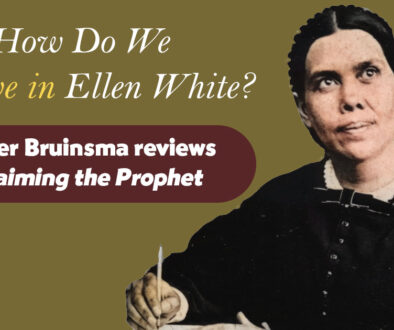Do Ordinary Christians Need Exorcisms?
by Stephen Ferguson | 9 January 2025
“Dear friends, do not believe every spirit, but test the spirits to see whether they are from God, because many false prophets have gone out into the world”—1 John 4:1.
Recently I had some Adventist friends ask my advice about demons. It had been put to them by other Adventist friends, who had attended a Pentecostal church-run seminar that fallen angels might be oppressing them. The suggested solution was a special type of healing, which would supposedly free them from these Satanic influences.
I reassured them they did not seem demon-possessed. While fallen angels might well be harassing them, this was largely normal. This happens to all of us, in one way or another, as part of our daily Christian walks in Christ.
My warning was that this cure might be worse than the supposed disease.
The day I attended my own exorcism
I was approached in part because my own experience of the demonic is relatively well known, as I have written about it. For those unaware of my story, a few years ago I attended what had been sold to me as a weekend “blessings workshop.” While it was not an Adventist seminar, I was invited by an Adventist friend. It did involve Adventist leaders, and some material used came from Adventist pastors.
I discovered I had in fact signed up for a “deliverance ministry” (DM) program, where participants were taught “Strategic Level Spiritual Warfare.” As well as a heavy dose of Prosperity Gospel (the course wasn’t free), the practical part of the workshop involved special prayer sessions.
The problem? With no warning, these prayer sessions turned out to be exorcisms!
Of course, the DM facilitators didn’t use the term “exorcism.” What used to be called demon possession was now described as demonization. And the rite that used to be called exorcism was now called either ekballo (from the Greek word to “cast out”) or simply deliverance.
Nonetheless, lest you still think we are not really dealing with exorcisms, DM guru and self-proclaimed prophetess Jennifer Eivaz acknowledges in the Inner Healing and Deliverance Handbook:
“Deliverance is the process of casting out demons.”[1]
Latin and holy water?
Today’s exorcists are no longer Catholic priests throwing holy water while speaking Latin. Now they’re run by Pentecostal megachurches with funky-sounding ministry names: Sozo, Heart Sync, Elijah House, Ancient Paths, Restoring the Foundations—to name a few.
As a generalization, these Pentecostal-based DMs typically involve a 90-minute to three-hour session, led by a sort of prophetic-medium who will usually claim a gift of prophecy. The DM practitioner has assistants, and many DM sessions are run in groups.
The exact process amongst DM practitioners might differ, but to take Mike Harding’s Sozo Training Manual as typical, he adopts a five-step process: forgiveness, inner healing (intercessory prayer), repentance (confession), deliverance (exorcism), and truth-therapy (memorizing Bible texts).[2]
The more disturbing aspects include the repentance phase, which can involve sensationalized confessions, supposedly to find the root or “open door” of demonic possession. People in our group confessed to rape, incest, and other truly horrendous incidents.
The demonic diagnosis is also usually linked to some pretty weird theology, including ancestral spirits, generational curses, and soul ties. Some DM practitioners are deep into divination tools and omens, such as finding signs in egg yolks or bird feathers. This sounds a little like Christian magic to me.
The high point of the DM session is the deliverance step. Harding suggests the recipient explicitly say:
“Spirit of [demon’s name], I command you in Jesus’ name to leave me!”[3]
Importantly, these DM sessions are not—I repeat not—performed on people who appear demonically possessed. These ceremonies are performed on seemingly normal Christians—people dealing with the normal ups-and-downs of life. In my own DM workshop, at no point did the facilitators even attempt to discern whether anyone, including me, was possessed.
As DM pioneer Derek Prince observed, conducting what is essentially an exorcism on a seemingly normal Christian is justified because:
“Many born-again Christians are still demonized. He said there are areas in their personality where the Holy Spirit is not yet in complete control because there is a demon that has to be dealt with.”[4]
Whether you are a believer in demons or a skeptic who just cares about good mental health practices for vulnerable people, much of contemporary DM should concern you. As a believer, I don’t deny the rare possibility of even a baptized, practicing Christian being possessed. However, these modern-day exorcisms are not approached as extraordinarily special events, but with the mundane regularity of a monthly visit to the chiropractor.
I do think forms of DM can be legitimate—I am not wholesale attacking DMs as done by all Pentecostal groups. Rather, I am raising concerns with some types of DM practiced by some practitioners.
Adventists and pentecostal DM
Perhaps understandably, given our own focus on the Great Controversy theme, Adventists seem increasingly attracted to DM. As far as my own experience goes, I am mostly, though not wholly, happy with Adventist-based DM.
One good Adventist source is the 2018 publication Finding Freedom in Jesus: A Deliverance Ministry Manual, put out by Adventist Frontier Missions and Andrews University.[5] This manual seemed to recognize:
- DM is a spectrum of practices, so nuance is warranted. Adventist-based DM is not—or should not be—the same as Pentecostal-based DM.
- DM involves a spiritual gift. Like all spiritual gifts, it won’t be for everyone but for those called to this specialist type of ministry.
- DM is not a trivial matter. It can be dangerous. The publication rightly notes biblical examples, such as the seven sons of Sceva, who were young Jewish exorcists beaten up by a demon for trying to use Jesus’ name as a sort of magical charm.
- There is real danger in mistaking demonic influence for some other more mundane physical or mental illness. DM should only be tried after orthodox medicine has been ruled out.
- Importantly, Adventist-based DM denounces common practices found within Pentecostal-based DM, including:
- performing DM sessions on a person who has not fully consented;
- talking to demons or trying to name them;
- using Jesus’ name in a magical way; and
- doing DM practices too often.
Demonic harassment vs demonic possession
Despite my general confidence in Adventist-based DM, as opposed to the Pentecostal kind, there is one area where I continue to feel some concern. This is the lack of clarity in distinguishing different levels of alleged demonic influence. In the special Ministry publication of April 2020, “And deliver us from evil,” Dr Kelvin Onongha explains:
“Demonic control over human lives can be understood as a continuum. At one end of the scale, demons are found active in the lives of all humans—harassing, influencing, tempting; seeking to gain access and control over their victims. At the other end is a state where the victims’ faculties and abilities are largely under demonic control; this is possession.”[6]
I think this is largely true, but it also illustrates a problem. In many DM publications, even Adventist ones, there is a lack of clarity as to whether authors are discussing demonic harassment or demonic possession, or something in between.
DM publications often refer to biblical examples, from Job to Paul, to illustrate that God’s people can be impacted by demons, which they then use to justify more invasive DM sessions. However, most of these biblical figures seem to be examples of demonic harassment—not demonic possession. There is no biblical evidence of Job or Paul ever needing an exorcism.
DM practitioners especially love to bring up Peter, to whom Jesus exclaimed: “Get behind me, Satan” (Matt. 16:23). Yet this passage does not suggest a form of possession. Importantly, while Jesus told Satan to get behind Him, Satan is not commanded to come out of Peter. In other words, this was again not an exorcism. Rather, Satan had tempted Peter to say something foolish, which we all do from time to time.
The demonic harassment of Job, Peter, Paul, or even Jesus Himself is contrasted with other biblical figures who clearly were demonized. For example, in the case of Judas the Bible says, “Then Satan entered Judas, called Iscariot, one of the Twelve” (Luke 22:3).
Playing with fire
From a secular and sceptical point of view, DM done badly risks getting a bunch of amateurs to attempt a form of psychotherapy without appropriate medical training and experience. Meanwhile, from a spiritual point of view, DM done badly risks exposing the participant to greater demonic control, not less:
“When the unclean spirit has gone out of the person, it passes through waterless places.… Then it goes and brings with it seven other spirits more evil than itself, and they enter and dwell there, and the last state of that person is worse than the first” (Matt. 12:43-45).
With many things to do with religion, a sensible middle course seems best. The counsel of C. S. Lewis in the preface to The Screwtape Letters seems an apt final warning for this subject:
“There are two equal and opposite errors which our race can fall into about the devils. One is to disbelieve in their existence. The other is to believe, and to feel an excessive and unhealthy interest in them. They themselves are equally pleased by both errors and hail a materialist or a magician with the same delight.”
- Jennifer Eivaz, Inner Healing and Deliverance Handbook, 2022, Baker Pub.: Grand Rapids, Loc. 397 and 14%. ↑
- Mike Harding, Sozo Training Manual for Sozo Ministry, 2005, Thomson Nelson Inc., Loc. 147 and 51%. ↑
- Ibid., at Loc. 147 and 51%. ↑
- See n1, at Loc. 1533 and 53%. ↑
- Bruce L. Bauer (ed.), Freedom in Jesus: A Deliverance Ministry Manual, 2018, Andrews University: Benton Harbor. ↑
- Kelvin Onongha, “And deliver us from evil”, Ministry Magazine, April 2020, page 12. ↑
 Stephen Ferguson is a lawyer from Perth, Western Australia, with expertise in planning, environment, immigration, and administrative-government law. He is married to Amy and has two children, William and Eloise. Stephen is a member of the Livingston Adventist Church.
Stephen Ferguson is a lawyer from Perth, Western Australia, with expertise in planning, environment, immigration, and administrative-government law. He is married to Amy and has two children, William and Eloise. Stephen is a member of the Livingston Adventist Church.
To comment, click/tap here.




